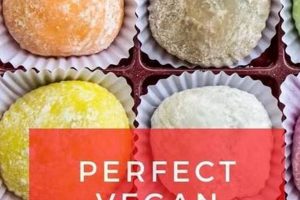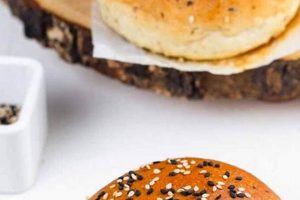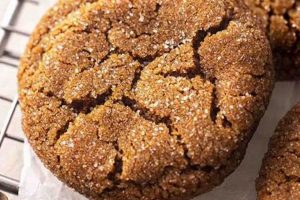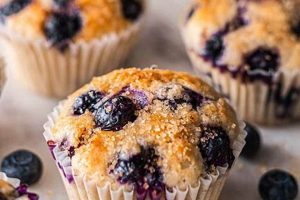Culinary preparations utilizing finely ground, dried coconut meat as a primary ingredient, while adhering to principles of plant-based diets, represent a specific category of food creation. These food items exclude all animal products, including meat, dairy, and eggs, relying instead on coconut flour’s unique properties and other plant-derived elements for structure and flavor. Examples include cakes, muffins, breads, and pancakes formulated without traditional wheat flour or animal-sourced components.
The significance of these culinary adaptations lies in their suitability for individuals with dietary restrictions, such as gluten intolerance or sensitivities, and those following vegan lifestyles. Benefits include provision of a grain-free alternative, a source of dietary fiber, and a different flavor profile compared to wheat-based products. Historically, these recipes have gained prominence alongside the rise in awareness of alternative diets and the increasing availability of coconut flour as a specialty ingredient.
The following sections will delve into specific aspects of crafting these specialized recipes, examining ingredient considerations, baking techniques, and potential challenges. This exploration aims to provide a practical understanding of how to successfully utilize coconut flour in the creation of delicious and nutritionally appropriate vegan dishes.
Tips for Successful Baking
Achieving optimal results when utilizing coconut flour in plant-based baking necessitates careful attention to specific techniques and ingredient interactions. The following tips provide guidance for navigating the unique properties of this ingredient and maximizing the success of vegan recipes.
Tip 1: Hydration is paramount. Coconut flour is exceptionally absorbent. Recipes require a significantly higher liquid-to-flour ratio compared to those using wheat flour. Failure to adequately hydrate the flour will result in a dry, crumbly final product. Adjust liquid quantities cautiously, adding small increments until the batter reaches a smooth, pourable consistency.
Tip 2: Binding agents are crucial. Vegan recipes, by definition, exclude eggs, which typically function as a binder. Coconut flour lacks gluten, further exacerbating binding challenges. Incorporate ingredients such as ground flaxseed, chia seeds, or applesauce to provide structure and prevent excessive crumbling. A combination of binding agents may be optimal for certain recipes.
Tip 3: Sifting is recommended. Coconut flour tends to clump. Sifting before incorporating it into wet ingredients ensures even distribution and prevents pockets of dry flour in the finished product. A fine-mesh sieve is suitable for this purpose.
Tip 4: Resting the batter is beneficial. Allowing the batter to rest for 5-10 minutes after mixing enables the coconut flour to fully absorb the liquid, improving the overall texture. This step is particularly important for recipes with a high proportion of coconut flour.
Tip 5: Oven temperature requires precision. Coconut flour baked goods can brown rapidly. Lowering the oven temperature by 25F (15C) compared to standard wheat flour recipes and monitoring the baking process closely can prevent over-browning. Covering the item with foil during the latter half of baking may also be necessary.
Tip 6: Consider complementary flavors. Coconut flour imparts a subtle coconut flavor. Utilize this characteristic to enhance the recipe with complementary flavors such as vanilla extract, almond extract, or citrus zest. Adjusting spices and flavorings to complement the coconut undertones can elevate the overall taste profile.
Tip 7: Storage requires airtight containers. Baked goods made with coconut flour tend to dry out quickly. Storing them in an airtight container at room temperature or in the refrigerator will help maintain their moisture and prevent them from becoming stale.
Adhering to these guidelines facilitates the creation of palatable and texturally pleasing vegan dishes incorporating this alternative flour. Understanding the properties of coconut flour and adapting standard baking techniques accordingly is essential for achieving successful and consistent results.
With these techniques mastered, it is useful to move on and consider specific “recipes with coconut flour vegan” to put these skills into practice.
1. Texture
Texture plays a critical role in the palatability and overall success of recipes utilizing coconut flour within vegan culinary practices. The inherent characteristics of coconut flour necessitate specific adjustments to achieve desired textures, diverging significantly from those obtained with traditional wheat-based formulations.
- Dryness and Crumbliness
Due to its high fiber content and superior absorbency, coconut flour exhibits a propensity for dryness and crumbliness in baked goods. Without proper hydration and binding, finished products are often unpleasantly dry and lack structural integrity. This characteristic dictates the need for increased liquid ratios and the incorporation of binding agents absent in many conventional recipes.
- Density and Heaviness
Coconut flour tends to produce denser, heavier results compared to lighter flours such as all-purpose or cake flour. This increased density can be advantageous in certain applications, such as muffins or brownies, but requires careful consideration in recipes where a light, airy texture is desired. Adjustments in leavening agents and ingredient ratios may be necessary to mitigate excessive density.
- Graininess
Depending on the fineness of the grind, coconut flour can impart a slightly grainy texture to the final product. This graininess can be minimized by using finely ground coconut flour and ensuring thorough mixing to allow for adequate hydration. Resting the batter or dough prior to baking can further reduce the perception of graininess.
- Moistness Retention
While coconut flour initially absorbs a substantial amount of liquid, it also possesses the capacity to retain moisture over time. This property can contribute to a desirable moistness in finished products, preventing them from becoming stale or dry. However, excessive moisture retention can lead to a gummy or overly dense texture, requiring careful balancing of ingredients and baking times.
The interplay between these textural characteristics necessitates a nuanced understanding of coconut flour’s behavior in vegan recipes. Strategic adjustments to hydration levels, binding agents, mixing techniques, and baking times are paramount to achieving the desired sensory attributes in these specialized culinary creations. Success in these areas unlocks the potential of this alternative flour to create palatable and satisfying foods for those with dietary restrictions and preferences.
2. Hydration
Hydration is a critical determinant in the success of culinary preparations incorporating coconut flour within vegan dietary guidelines. Coconut flour exhibits a significantly higher liquid absorption capacity compared to traditional wheat-based flours. This characteristic stems from its high fiber content, primarily insoluble fiber, which binds to water molecules, effectively removing free moisture from the batter or dough. Insufficient hydration leads to a final product characterized by dryness, crumbliness, and an unpalatable texture. For instance, a vegan coconut flour muffin recipe, if formulated with inadequate liquid, will yield a dense, dry muffin prone to crumbling, irrespective of other ingredients. This underscores the direct causal relationship between hydration levels and the textural integrity of the resulting baked good.
The practical significance of understanding this relationship manifests in recipe formulation and execution. Effective vegan coconut flour recipes compensate for the flour’s absorbent nature by incorporating substantially more liquid than their wheat-based counterparts. Liquid additions can take various forms, including non-dairy milk, applesauce, pureed fruits, or vegetable oils. The specific type and quantity of liquid are dictated by the desired flavor profile and textural characteristics of the final product. A vegan coconut flour pancake recipe, for example, might necessitate double the amount of non-dairy milk compared to a conventional pancake recipe to achieve a pourable batter consistency. Furthermore, the order in which ingredients are combined can influence hydration; allowing the coconut flour to soak in liquid for a short period prior to incorporating other dry ingredients can enhance its moisture absorption and improve the final texture.
In summary, the hydration component is essential for producing successful vegan recipes that involve coconut flour. The flour’s high absorption capacity means proper hydration can solve the challenges of dryness and crumbliness that might otherwise compromise the quality of these baked goods. Addressing this need through precise liquid-to-flour ratios and strategic ingredient combinations facilitates the creation of palatable and texturally pleasing vegan dishes, expanding the range of options for individuals adhering to plant-based diets. Understanding this factor is a vital element in all recipes utilizing coconut flour within vegan cuisine, and failure to consider it is likely to lead to unfavorable results.
3. Binding
The structural integrity of baked goods relies heavily on the phenomenon of binding, particularly within vegan recipes utilizing coconut flour. Conventional baking leverages gluten, a protein complex present in wheat flour, to provide elasticity and cohesion. Vegan formulations, by definition, exclude eggs, which also contribute to binding. Coconut flour, inherently gluten-free, necessitates the incorporation of alternative binding agents to compensate for the absence of these traditional components. The omission of effective binding agents results in a crumbly, structurally unstable product, rendering it unpalatable and difficult to handle. For example, a vegan coconut flour bread made without any binding additions would likely disintegrate upon slicing due to a lack of internal cohesion.
Effective binding agents in vegan coconut flour recipes include chia seeds, flax seeds (often ground into meal), psyllium husk, applesauce, and certain starches such as tapioca or arrowroot. These ingredients contribute to the overall structure by absorbing moisture and forming a viscous matrix that holds the ingredients together. Chia and flax seeds, when combined with water, develop a gel-like consistency that mimics the binding properties of eggs. Applesauce adds moisture and pectin, which further enhances cohesion. Psyllium husk, due to its high fiber content, also forms a gel-like substance when hydrated, improving the texture and structural stability of baked goods. The specific choice and quantity of binding agents depend on the desired texture and flavor profile of the final product.
In summary, the role of binding agents in vegan coconut flour recipes is paramount to achieving desirable textural characteristics and structural stability. These components compensate for the absence of gluten and eggs by providing cohesion and preventing excessive crumbling. Understanding the properties of different binding agents and their impact on the final product enables the creation of palatable and structurally sound vegan baked goods utilizing this alternative flour. The careful selection and incorporation of binding agents are, therefore, essential for success in this culinary domain.
4. Flavor
The intrinsic flavor profile of coconut flour exerts a significant influence on the overall gustatory experience of recipes adhering to both vegan dietary principles and coconut flour as a primary ingredient. Coconut flour, derived from dried and ground coconut meat, inherently imparts a subtle sweetness and a distinct coconut aroma to culinary creations. This characteristic must be considered during recipe formulation to ensure a balanced and harmonious flavor profile. For instance, in the absence of careful flavor balancing, a vegan coconut flour cake might exhibit an overwhelming coconut taste, potentially overshadowing other intended flavor components. This presents a critical consideration for recipe developers.
Effective utilization of coconut flour necessitates a strategic approach to flavor pairings. Compatible flavor profiles include vanilla, almond, chocolate, tropical fruits, and spices such as cinnamon or nutmeg. Conversely, flavors that clash with coconut, such as overly acidic or savory profiles, require careful modulation. Consider a vegan coconut flour curry; while coconut milk is a common ingredient in many curries, using coconut flour would necessitate meticulous adjustment of spice levels and acidic components to prevent an unbalanced and potentially unpalatable outcome. The practical application of this understanding translates into selecting compatible ingredients and adjusting their proportions to complement, rather than compete with, the inherent coconut flavor.
In conclusion, the subtle sweetness and distinct aroma of coconut flour profoundly impact the flavor outcome of vegan recipes. Success hinges on a thoughtful selection of complementary flavors and a careful modulation of ingredients to achieve a harmonious balance. Failure to address this fundamental element can result in an imbalanced and undesirable flavor profile. Therefore, the role of flavor is not merely an additive component but an intrinsic aspect that requires deliberate consideration when crafting recipes employing coconut flour within vegan culinary practices.
5. Adaptation
The success of utilizing coconut flour in vegan recipes hinges significantly on adaptation a process of modifying conventional cooking techniques and ingredient ratios to accommodate the flour’s unique properties. Coconut flour’s high absorbency and lack of gluten necessitate substantial adjustments compared to traditional wheat-based recipes. Without adaptation, the resulting baked goods are often dry, crumbly, and structurally unsound. A direct cause-and-effect relationship exists: the failure to adapt recipes to account for coconut flours characteristics directly results in unsatisfactory culinary outcomes. The importance of adaptation as a component of vegan recipes using coconut flour cannot be overstated; it is the bridge between traditional baking knowledge and the specific requirements of this alternative ingredient.
Practical examples of adaptation include increasing the liquid content of recipes, incorporating binding agents such as flaxseed meal or chia seeds, and adjusting baking times and temperatures. For instance, a standard vegan chocolate chip cookie recipe, when adapted for coconut flour, requires a higher proportion of wet ingredients to counteract the flour’s drying effect. Moreover, due to the absence of gluten, a binding agent must be included to provide structure and prevent the cookies from crumbling. The baking time might also need to be reduced to prevent over-browning, as coconut flour tends to brown more rapidly than wheat flour. These adaptations are not merely minor adjustments; they represent fundamental alterations necessary to achieve a palatable and structurally sound final product.
In conclusion, adaptation is not just a recommendation but a mandatory requirement for crafting successful vegan recipes with coconut flour. The challenges presented by the flour’s unique properties necessitate a comprehensive understanding of how to modify conventional recipes and techniques. Embracing adaptation ensures that coconut flour can be effectively incorporated into vegan cuisine, expanding the options for individuals with dietary restrictions and preferences. The practical significance of this understanding lies in the ability to create delicious, texturally pleasing, and structurally sound baked goods that align with both vegan principles and the specific characteristics of coconut flour.
Frequently Asked Questions
This section addresses common inquiries regarding the utilization of coconut flour in vegan culinary preparations. The following questions and answers aim to provide clarity and guidance for successful recipe execution.
Question 1: Why do recipes using coconut flour often require more liquid than traditional recipes?
Coconut flour possesses an exceptionally high absorption capacity due to its elevated fiber content. This necessitates a greater liquid-to-flour ratio to achieve the desired consistency and prevent excessive dryness in the final product.
Question 2: What are suitable substitutes for eggs in vegan recipes utilizing coconut flour?
Effective egg substitutes include flaxseed meal mixed with water, chia seeds mixed with water, applesauce, and commercial vegan egg replacers. These ingredients provide binding and moisture, compensating for the absence of eggs.
Question 3: How does coconut flour affect the texture of baked goods?
Coconut flour tends to produce a denser, slightly drier texture compared to wheat flour. Proper hydration and the incorporation of binding agents are crucial to mitigating these effects and achieving a palatable texture.
Question 4: Can coconut flour be used as a direct substitute for wheat flour in any recipe?
Coconut flour is not a direct substitute for wheat flour. Due to its unique properties, recipes require significant adjustments in liquid content, binding agents, and potentially other ingredients to achieve comparable results. A one-to-one substitution is not recommended.
Question 5: What are the best storage practices for baked goods made with coconut flour?
Baked goods made with coconut flour should be stored in an airtight container at room temperature or in the refrigerator to prevent drying out. Proper storage helps to maintain moisture and prevent staleness.
Question 6: How does the coconut flavor impact recipe development?
Coconut flour imparts a subtle coconut flavor to baked goods. Recipe development should consider complementary flavors, such as vanilla, chocolate, or tropical fruits, to create a balanced and harmonious taste profile.
These FAQs highlight critical aspects of working with coconut flour in vegan cooking, from understanding its unique absorption to mitigating its textural impact and complementing its distinct flavour. It is of utmost importance to be aware of these characteristics to successfully utilize coconut flour in a vegan kitchen.
The following sections will explore detailed recipes.
Conclusion
The preceding discussion has elucidated the critical factors governing the successful execution of “recipes with coconut flour vegan.” The inherent characteristics of coconut flour, including its high absorbency, gluten-free nature, and distinct flavor profile, necessitate strategic adjustments to traditional baking techniques. A thorough understanding of hydration requirements, binding agents, and flavor pairings is essential for achieving palatable and texturally pleasing results. Furthermore, adaptation of conventional recipes is not merely recommended but rather a mandatory step for ensuring structural integrity and preventing undesirable outcomes.
The informed application of these principles empowers culinary practitioners to expand the repertoire of vegan options, offering a viable alternative to wheat-based products while accommodating dietary restrictions and preferences. Continued exploration and refinement of “recipes with coconut flour vegan” hold the potential to further enhance the quality and accessibility of plant-based cuisine. As consumer interest in alternative ingredients grows, mastery of these techniques becomes increasingly significant for both home cooks and professional chefs seeking to cater to diverse dietary needs and preferences.







